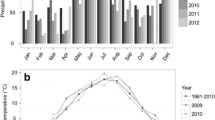Abstract
Alley cropping was introduced in the humid forest zone of Cameroon to increase soil fertility in 1987, but until 1992 the adoption rate had remained low. To better understand the reasons behind this, three types of on farm trials were established from fully researcher controlled to fully farmer controlled. During the evaluation of the technology with farmers a number of modifications were registered (1) Pruning height and frequency: Because of the difficulties to consistently cut back at 30 cm, farmers decided to slash at ground level as they normally do while slashing the natural fallow vegetation. This equally allowed for more flexibility in time of pruning. (2) Cropping intensity and pattern: Initially, alleys were cropped each year. This however had several shortcomings. Having observed the positive impact of incidental fallow period in a farmer's field, it was decided to introduce a fallow phase of at least one year. During the fallow period the plot can be used for fodder production, bee farming and production of stakes. (3) Residue management: Fire went incidentally in a farmer's tree plot after slashing, and the trees were not affected. This gave farmers an alternative way to manage the residue, by controlling the fire, before bringing in other crops such as groundnut and cassava. (4) Agroforestry species: Because Leucaena leucocephala, in spite of it soil fertility restoration potential, rapidly became a noxious weed, farmers have asked for a less invasive species. Calliandra calothyrsus was introduced for this purpose and became a good bee forage. With these modifications, the original alley cropping system has evolved into a rotational tree fallow with higher adoption potential. From about 15 farmers who were testing the technology in 1992, the number increased to 52 in 1996, 120 in 1997 and 236 in 1998.
Similar content being viewed by others
References
Ashby JA (1986) Methodology for the participation of small farmers in the design of off-farm trials. Agricultural Administration 22: 1-19
Ashby JA and Sperling L (1995) Institutionalizing participa-tory, client driven research and technology development in agriculture. Development and Change 26: 753-770
Degrande A and Duguma B (2000) Adoption potential of rota-tional hedgerow intercropping in the humid lowlands of Cameroon. Agricultural Research Network Paper No. 103, ODI
Duguma B and Mollet M (1997) Provenance evaluation of Calliandra calothyrsus meissner in the humid lowlands of Cameroon. Agroforestry Systems 37: 45-57
Franzel S (1999) Socioeconomic factors affecting the adoption potential of improved tree fallows in Africa. Agroforestry Systems 47: 305-321
Franzel S, Phiri D and Kwesiga FR (1999) Assessing the adoption potential of improved fallows in Eastern Zambia. AFRENA Working Paper No. 124, ICRAF, Nairobi, Kenya
Fujisaka S, Wortmann C and Adamassu H (1996) Resource poor farmers with complex technical knowledge in the high-risk system in Ethiopia: Can research help? Journal of Farming Systems Research-extension 6(3): 1-14
IRAD (Institut de la Recherche Agricole pour le Développement)/ICRAF (1993) Annual Progress Report.
IRAD/ICRAF Project, Yaoundé, Cameroon, 61 pp IRAD (Institut de la Recherche Agricole pour le Développement)/ICRAF (1996) Annual Progress Report. IRAD/ICRAF Project, Yaoundé, Cameroon, 67 pp
IRAD (Institut de la Recherche Agricole pour le Développement)/ICRAF (1997) Annual Progress Report IRAD/ICRAF Project, Yaoundé, Cameroon, 61 pp
Kang and Sajjapongse A (1980) Effects of heating on prop-erties of some soils from southern Nigeria and growth of rice. Plant and Soil 55: 85-95
Kang BT (1997) Alley cropping: Soil productivity and nutrient recycling. Forest Ecology and Management 91: 75-82
Muschler RG and Bonnemann A (1997) Potentials and limi-tations of agroforestry for changing land-use in the tropics: Experiences from Central America. Forest Ecology and Management 91: 61-73
Mutsaers HJW, Mbouemboue P and Mouzong Boyomo (1981) Traditional food crops growing in the Yaoundé area (Cameroon). Part II. Crop production, yields and fertility aspects. Agro-ecosystems 6: 289-303
Place F and Dewees P (1999) Policies and incentives for the adoption of improved fallows. Agroforetry Systems 47: 323-343
Rocheleau DE (1991) Participatory research in agroforestry: learning from experience and expanding our repertoire. Agroforestry Systems 15: 111-137
Scherr SJ (1991) On farm research: The challenges of agro-forestry. Agroforestry Systems 15: 95-110
Shepherd KD, Ndufa JK, Ohlsons E, Sjogren H and Swinkels R (1997) Adoption potentials of hedgerow intercropping in maize-based cropping systems in the highlands of western Kenya. I Background and agronomic evaluation. Expl Agric (33): 197-209
Tonye J, Duguma B and Tiki Manga T (1994) Stepwise approach to alley cropping technology development and transfer in the forest zone of Cameroon. Agroforestry Systems 28: 269-278
Tonye J, Ibewiro B and Duguma B (1997) Residue manage-ment of a planted fallow on an acid soil in Cameroon: Crop yields and soil organic matter fraction. Agroforestry Systems 37: 199-207
Author information
Authors and Affiliations
Rights and permissions
About this article
Cite this article
Kanmegne, J., Degrande, A. From alley cropping to rotational fallow: Farmers' involvement in the development of fallow management techniques in the humid forest zone of Cameroon. Agroforestry Systems 54, 115–120 (2002). https://doi.org/10.1023/A:1015095320293
Issue Date:
DOI: https://doi.org/10.1023/A:1015095320293




